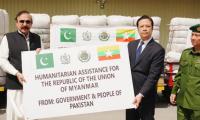The Guantanamo Bay detention centre remains a sordid emblem of torture, indefinite incarceration and gross human right violations. The Presidential Military Order that enabled it was “to detain and try suspects for violation of the laws of war and other applicable laws”. The malicious dichotomy was that these individuals were detained at Guantanamo because no court had any jurisdiction there. This was a premeditated ploy to arbitrarily revoke the universally accepted right of these detainees to a free and fair trial.
Of the 779 men incarcerated at Guantanamo, nine committed suicide. Five pleaded guilty as a result of pre-trial agreements before a military commission. Devoid of any legal recourse whatsoever, a guilty plea was the only means to be shifted out of what was an infernal island to a US federal prison. According to case files, 17 detainees were below the age of 18 and two were below 14, while 732 detainees were released without ever being charged. They remain scarred for life due to the years long horrors meted onto them.
A Wikileaks 2011 document labeled “Matrix of threat indicators for enemy combatants” exhorted the ludicrous paradigm of Muslims wearing Casio F91W watches being potential suicide bombers. Dubbed the “terrorist watch”, this was because of its capacity to set a bomb timer beyond 24 hours. Case files of at least 50 detainees show they were arrested after random checks found them wearing these watches. Transcripts cited their wearing a Casio as “unclassified evidence of being a terrorist”.
General Geoffrey Miller, Commander Joint Task Force Guantanamo, described the island prison as “a central laboratory for the war on terror”. This war was a planned conduit to imperialism and a carte blanche to capture and torture Muslims. In September 2003, Miller led a special team to Iraq to impart “interrogation techniques”. In Iraq alone, the post 9/11 years saw over 100,000 prisoners pass through the horrific US run detention system. Over 8000 of these were held at the infamous Abu Ghraib prison. Their inhuman internment had Seymour Hersh remarking that “Abu Ghraib had in effect become another Guantanamo”.
Written with toothpaste, scratched into Styrofoam cups or etched into napkins with fingernails, ‘The Poems from Guantanamo’ is a set of 22 poems. These were smuggled out by the detainees over decades and published by Marc Falkoff, professor at Northern Illinois University of Law. The agonizing plea in ‘Death Poem’ by 33-year-old Jumah al Dossari from Bahrain is to “let them bear the guilty burden before the world, their children and history, of this wasted sinless soul which has suffered at the hands of the protectors of peace”. Dossari was held in solitary confinement for five years; he tried to kill himself twelve times. He was released in 2007 without ever being charged.
“It is like being alive in your own grave”. These were the words with which Saifullah Paracha described Guantanamo. A successful Karachi businessman, he was abducted in 2003 by US agents who had lured him to Bangkok. Held and tortured at Guantanamo for 19 years, he was one of the 17 people “detained indefinitely” and dubbed the “forever prisoners” by human rights organizations. He was finally released recently without ever being charged or having faced a trial.
Uzair, Saifullah Paracha’s 23-year-old son, was picked up in 2003 too from New York. An IBA graduate, he was charged with helping suspected militants to enter the US and sentenced to 30 years in prison. In 2020, Judge Sidney Stein overturned the sentence calling it “a manifest injustice to let the conviction stand”. Uzair gave up his US resident status and came back to Pakistan after languishing for 17 years in the harshest of US federal prisons. Ever subdued, nobody from our side dared question Washington for this appalling travesty of human rights.
Guantanamo has cost the US taxpayer over $6 billion. The 20-year Afghan war was a criminal adventure that killed and maimed millions while costing the same taxpayer over $3 trillion. These inhuman excesses saw Guantanamo compromising US national security by becoming a recruiting tool for militants. The futility of these atrocities also lay bare when leading Washington officials sat across the table at Doha with five Afghans, each having been detained at Guantanamo for an average 13 years, to broker a safe yet humiliating exit for American troops from Afghanistan.
Guantanamo remains a reprehensible edifice symbolizing the debasement of humanity. Washington chooses to continue living with its moral and legal stain of systematic torture and utter disdain for rule of law. No contradiction could be starker than the US assigning itself the role of a champion of human rights. A dichotomy drenched in blood, Washington uses this self-ordained crown to atrociously violate humanity across the world with contempt and impunity.
Successive US presidents have promised to shut down Guantanamo; the symbol that further blights Washington’s ever eroding moral authority still persists. In a December 2021 Senate Judiciary Committee hearing, US senators called Guantanamo “a stain on the moral fiber of America”.
More than two decades ago, Marine Corps Major General Michael Lehnert was tasked with building the first cells at Guantanamo and remained its first commander. He deposed at the same hearing: “I was given 96 hours to open Guantanamo, now I want it shut down. History shall judge America harshly if we do not. Who we are cannot be separated from what we do”.
The writer is a freelance contributor. He can be reached at miradnanaziz@gmail.com
This demand has fueled rapid growth deposit base of Islamic Banks and Islamic Windows operated by conventional banks
But Punjab Agriculture Food and Drug Authority building near Thokar Niazbeg on Multan Road stands out
Macron has been particularly vocal in their criticism, asserting that withholding arms from Kyiv plays directly into...
As PPP governs province, Bilawal Bhutto Zardari holds strategic position to address both violence and its underlying...
Critics argue that strategy is vague, but closer look indicates strategic alignment with global trends and national...
To defeat it, we must distrust bot-driven narratives, to defeat it, we must verify sources before believing or sharing







